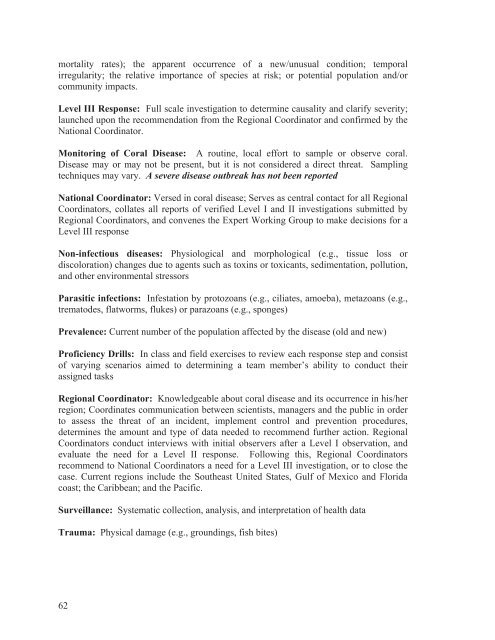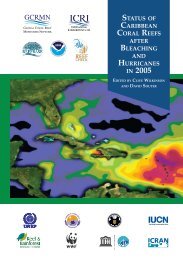mortality rates); <strong>the</strong> apparent occurrence <strong>of</strong> a new/unusual condition; temporalirregularity; <strong>the</strong> relative importance <strong>of</strong> species at risk; or potential population and/orcommunity impacts.Level III Response: Full scale investigation to determine causality and clarify severity;launched upon <strong>the</strong> recommendation from <strong>the</strong> Regional Coordinator and confirmed by <strong>the</strong>National Coordinator.Monitoring <strong>of</strong> <strong>Coral</strong> <strong>Disease</strong>: A routine, local ef<strong>for</strong>t to sample or observe coral.<strong>Disease</strong> may or may not be present, but it is not considered a direct threat. Samplingtechniques may vary. A severe disease outbreak has not been reportedNational Coordinator: Versed in coral disease; Serves as central contact <strong>for</strong> all RegionalCoordinators, collates all reports <strong>of</strong> verified Level I and II investigations submitted byRegional Coordinators, and convenes <strong>the</strong> Expert Working Group to make decisions <strong>for</strong> aLevel III responseNon-infectious diseases: Physiological and morphological (e.g., tissue loss ordiscoloration) changes due to agents such as toxins or toxicants, sedimentation, pollution,and o<strong>the</strong>r environmental stressorsParasitic infections: Infestation by protozoans (e.g., ciliates, amoeba), metazoans (e.g.,trematodes, flatworms, flukes) or parazoans (e.g., sponges)Prevalence: Current number <strong>of</strong> <strong>the</strong> population affected by <strong>the</strong> disease (old and new)Pr<strong>of</strong>iciency Drills: In class and field exercises to review each response step and consist<strong>of</strong> varying scenarios aimed to determining a team member’s ability to conduct <strong>the</strong>irassigned tasksRegional Coordinator: Knowledgeable about coral disease and its occurrence in his/herregion; Coordinates communication between scientists, managers and <strong>the</strong> public in orderto assess <strong>the</strong> threat <strong>of</strong> an incident, implement control and prevention procedures,determines <strong>the</strong> amount and type <strong>of</strong> data needed to recommend fur<strong>the</strong>r action. RegionalCoordinators conduct interviews with initial observers after a Level I observation, andevaluate <strong>the</strong> need <strong>for</strong> a Level II response. Following this, Regional Coordinatorsrecommend to National Coordinators a need <strong>for</strong> a Level III investigation, or to close <strong>the</strong>case. Current regions include <strong>the</strong> Sou<strong>the</strong>ast United States, Gulf <strong>of</strong> Mexico and Floridacoast; <strong>the</strong> Caribbean; and <strong>the</strong> Pacific.Surveillance: Systematic collection, analysis, and interpretation <strong>of</strong> health dataTrauma: Physical damage (e.g., groundings, fish bites)62
ReferencesU.S. National Response Team. 2000a. Incident Command System/Unified Command(ICS/UC); Technical Assistance Document. http://www.nrt.org/.ICRIN. 2000b. International <strong>Coral</strong> Reef In<strong>for</strong>mation Network.http://www.icri<strong>for</strong>um.org/ICRIN/icrin.htm.CRMP, NOAA Florida Keys National Marine Sanctuary. 2001. <strong>Coral</strong>/HardbottomMonitoring Project (CRMP) Steering Committee Report, Executive Summary.American Association <strong>of</strong> Zoo Veterinarians (AAZV). 2008. Principles <strong>of</strong> <strong>Disease</strong>Outbreak <strong>Investigation</strong>-A Didactic. http://www.aazv.org/.Bellwood, D. R., Hughes, T. P., Folke, C. and Nystrom, M. 2004. Confronting <strong>the</strong> coralreef crisis. Nature 429: 827-833.Bryant, D., Burke, L., Mc Manus, J. and Spalding, M. 1998. Reefs at Risk: A mapbasedindicator <strong>of</strong> threats to <strong>the</strong> world's coral reefs. World Resources Institute,Washington, DC. 56p.Daszak, P., Cunningham, A. A. and Hyatt, A. D. 2001. Anthropogenic environmentalchange and <strong>the</strong> emergence <strong>of</strong> infectious diseases in wildlife. Acta Trop. 78: 103-116.Deem, S. L., Karesh, W. B. and Weisman, W. 2001. Putting <strong>the</strong>ory into practice: Wildlifehealth in conservation. Conservation Biology 15: 1224-1233.Domart-Coulon, I., Traylor-Knowles, N., Peters, E., Elbert, D., Downs, C., Price, K.,Stubbs, J., Mc Laughlin, S., Cox, E., Aeby, G., Brown, P. and Ostrander, G. 2006.Comprehensive characterization <strong>of</strong> skeletal tissue growth anomalies <strong>of</strong> <strong>the</strong> fingercoral Porites compressa. <strong>Coral</strong> Reefs 25: 531-543.Downs, C. A. 2005a. Cellular diagnostics and its application to aquatic and marinetoxicology, In G. Ostrander [ed.], Techniques in Aquatic Toxicology. CRC Press,Inc. 2: 301-313.---. 2005b. Sampling, Biomarker, and Contaminant Chemical Target Analyte Protocols.WWF and Mesoamerican Alliance <strong>of</strong> <strong>the</strong> International <strong>Coral</strong> Reef ActionNetwork, 60pp.Friend, M. 2006. <strong>Disease</strong> Emergence and Resurgence: The Wildlife-HumanConnection, Circular 1285. U.S. Geological Survey, Reston, VA. 400p.Friend, M. and Franson, J. C. 1999. <strong>Field</strong> <strong>Manual</strong> <strong>of</strong> Wildlife <strong>Disease</strong>s, General <strong>Field</strong>Procedures and <strong>Disease</strong> <strong>of</strong> Birds, In<strong>for</strong>mation and Technology Report 1999-001.U.S. Geological Survey, Madison, WI. 426p.http://www.emtc.usgs.gov/nwhchome.htmlGardner, T. A., Cote, I. M., Gill, J. A., Grant, A. and Watkinson, A. R. 2003. Long-TermRegion-Wide Declines in Caribbean <strong>Coral</strong>s. Science 301: 958-960.Geraci, J. R. and Lounsbury, V. J. 1993. Marine Mammals Ashore, A field guide <strong>for</strong>strandings. Texas A&M Sea Grant Publication (TAMU-SG-93-601), 305p.Goreau, T., Mc Clanahan, T., Hayes, R. and Strong, A. 2000. Conservation <strong>of</strong> <strong>Coral</strong>Reefs after <strong>the</strong> 1998 Global Bleaching Event. Conservation Biology 14: 5-15.Halpin, B. 1975. Patterns <strong>of</strong> Animal <strong>Disease</strong>. Bailliere Tindall, London. 184p.Hoegh-Guldberg, O. 1999. Climate change, coral bleaching and <strong>the</strong> future <strong>of</strong> <strong>the</strong> world'scoral reefs. Mar. Freshwat. Res. 50: 839-866.63
- Page 2 and 3:
DisclaimerThe contents of this docu
- Page 5 and 6:
PREFACECoral reefs throughout their
- Page 7 and 8:
ACKNOWLEDGMENTSWe would like to ack
- Page 9:
CHAPTER 4 CASE HISTORY, SAMPLE COLL
- Page 12 and 13:
diseases, however, remain elusive a
- Page 16 and 17:
species of interest or manifesting
- Page 18 and 19:
statistically significant and biolo
- Page 20 and 21:
2.2 Regulatory AuthorityThe Respons
- Page 22 and 23: Review and assist in development of
- Page 24 and 25: familiar with such protocols, and w
- Page 26 and 27: incident operations. The IC sets pr
- Page 28 and 29: Sampling Kits: Pre-assembled kits w
- Page 30 and 31: Chapter 3Incident Command System3.1
- Page 32 and 33: 3.4 ICS Roles and Responsibilities3
- Page 34 and 35: 3.5 Establishing a Command/Operatio
- Page 36 and 37: Coral Disease Investigation Decisio
- Page 38 and 39: zooxanthellae), or completely absen
- Page 40 and 41: 3.6.4 Launching an Investigation: L
- Page 42 and 43: Chapter 4Case History, Sample Colle
- Page 44 and 45: 4.4 Survey Team- Site Identificatio
- Page 46 and 47: site, complexity of the reef, and e
- Page 48 and 49: 4.4.3.2 Possible Modifications to C
- Page 50 and 51: 4.4.5 Field Microscopy4.4.5.1 Intro
- Page 52 and 53: 4.4.5.3 Use of Stereo MicroscopeThe
- Page 54 and 55: Collection Form, and will ferry tim
- Page 56 and 57: Due to time sensitivity of some sam
- Page 58 and 59: protein chemistry based and include
- Page 60 and 61: Tissue for Microbiology (H-B, U-B,
- Page 62 and 63: When shipping coral samples from ou
- Page 64 and 65: 4.10.2 MicrobiologyMicrobiology is
- Page 66 and 67: Chapter 5Health and Safety5.1 Safet
- Page 68 and 69: 5.4 Precautions in the FieldCoral H
- Page 70 and 71: Glossary of TermsBleaching: Loss or
- Page 74 and 75: Knowlton, N. 2001. The future of co
- Page 76 and 77: 66Appendices
- Page 78 and 79: Appendix II.Level I Data - Coral Di
- Page 80 and 81: Level II Data: Coral Disease Event
- Page 82 and 83: Appendix V. Support Team Processing
- Page 85 and 86: Appendix VII.DocumentsCollection Pe
- Page 87 and 88: called a Common Main Objective (CMO
- Page 89 and 90: With reasonable care stereo microsc
- Page 91: United States Department of Commerc
















